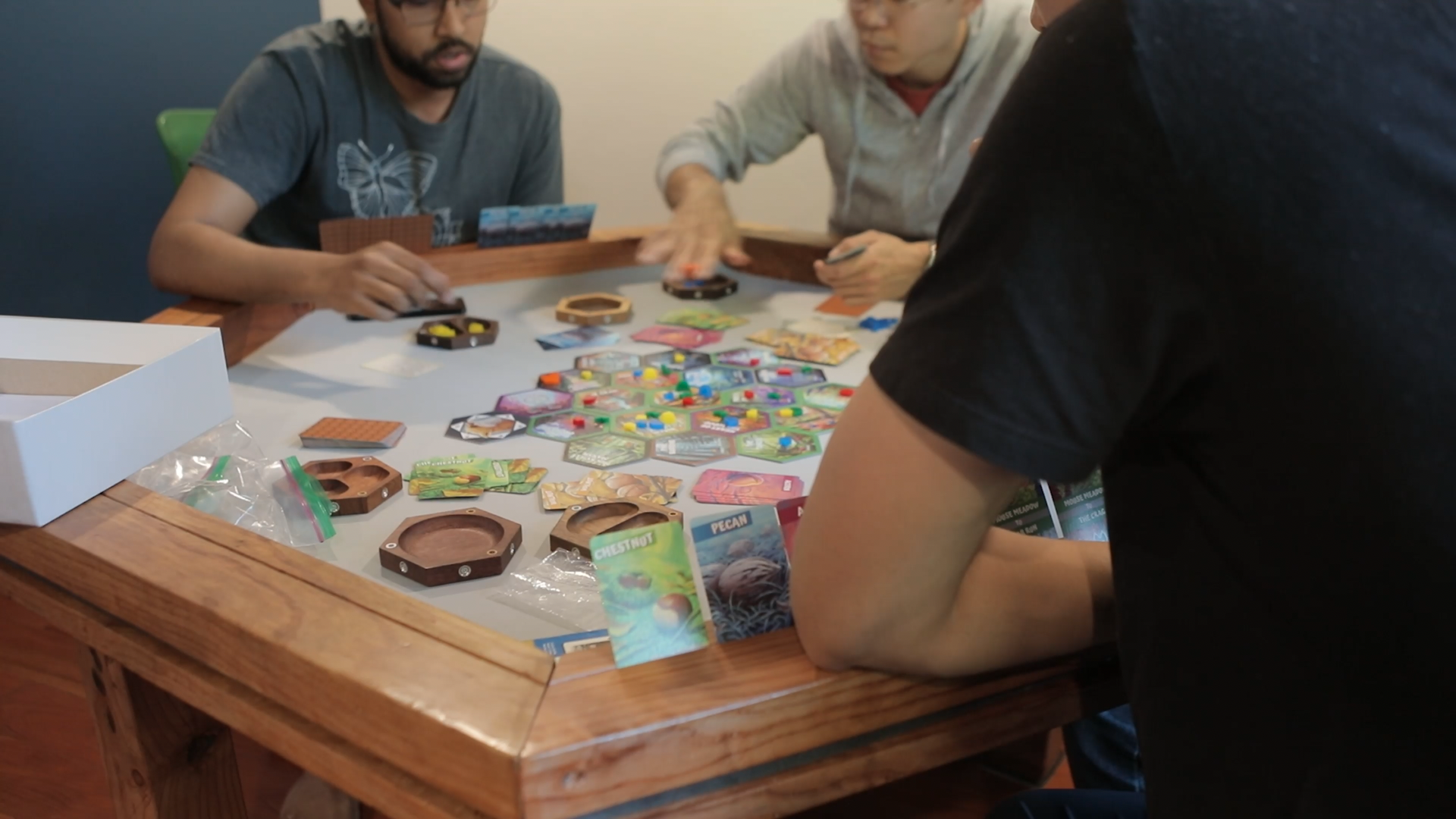Nut Hunt Review
An engrossing movement system with plenty of nuts.
1-5 players complete paths through a forest by placing squirrels and nests throughout, all while using a unique scurrying mechanic. Plays in 30-45 minutes.
Video published June 6th, 2021

Place carefully on the board, to link your paths together.

Handle your hand of nuts.

Constant interactive scurrying of squirrels.
Overview & How to Play
This is a sponsored review.
Nut Hunt is probably the nuttiest game we’ll review here at Shelfside!
Your goal is to connect locations on the board, that are depicted via objectives, of which you start the game with two of. At game end, you want to have pieces on the board connecting the two named tiles.
Every turn, all players do is two things: roll the die to move a neutral Fox around the board, then do one more action. The Fox moves one space, then you pick up nuts from where it lands. But then, here’s the big mechanic: if the Fox lands on a space with Squirrels, yours or anyone else’s, those Squirrels have to ‘scatter’ away. In player order, the Squirrels all flee that hex, moving to an adjacent hex.
That ends the Fox movement, so then you can choose 1 of 3 extra actions to take. The main one will be spawning more Squirrels by paying its cost on the tile its getting placed on. Or players can hassle the Fox to move it one more space to where they have pieces, scattering Squirrels. The last action is to draw an objective into your hand.
One crucial thing are the Nests, which are like bases for your color. Once you have them down, they can never move away from that color. To make one, it is just anytime you have 3 Squirrels on one space.
The end of the game is triggered when someone puts down their 4th Nest, then players score points off of objectives completed, and the path for those objectives have to have at least 1 nest within it.
Pros
Nut Hunt has the same graphic artist as Scythe and Wingspan, with lots of texture and different types of hexes to start pulling you into this fantasy forest land. There’s a “Froggy Pond”, or the “Giant Toadstool” for your Squirrels to hang out in. Nut cards are also super distinct.
Let’s jump to the umbrella of the fascinating movement system in this game. Your main units, your Squirrels, are exclusively tied to being moved by the other things, namely the Fox that moves every turn, or new nests. It’s this immediate nuance in how you approach the map, where you have to think about Squirrel movement to gain advantage, but to do so, you have to start looking all around the map for the ingredients to move them.
The whole movement idea gets reinforced by choosing where you want to hunker down and NOT move by upgrading to nests. Not only are you permanently on that hex for the rest of the game, but by building a Nest, you immediately force opponents’ squirrels on that space to scatter, letting you counterplay opponents if you can guess their objectives.
Pretty much everyone’s actions are interconnected with Squirrels popping up left and right. You’ll very frequently be forced to move YOUR Squirrels on someone else’s turn, sometimes twice if they hassle the Fox ON TOP of moving him normally. Or you scatter twice on someone’s turn if they move the Fox normally, then play a Squirrel to build a nest, then you scatter- and you can decide to build your own nest! This nut game just invites constant engagement.
Nut Hunt also has a great progression, with more Squirrels accumulating on the board leading to more Nests to cement your influence on certain hexes, and there’s the option to draw MORE objectives if you want to attempt them. Objectives in general make end game scoring quite dynamic, as you don’t really know who is going to win with objectives being positive, or negative points.
Cons & Nitpicks
But. Objectives have some problems of their own, where they’re far too swingy and unpredictable. This goes hand in hand with the modular board, where the difficulty of objectives sometimes feels moot, since you can just scurry Squirrels into a ‘difficult’ hex, especially early to mid game. We would have liked at least some hex spaces to be always be placed in specific areas during setup.
Objectives are also a little too hidden right now, where you have zero tangible information of what your opponents are trying to accumplish. Rather, the game wants you to predict their cards, of a deck of 45 objectives where you only see other cards at the end of game. Counterplay in general can be difficult because of how ‘scurrying’ is a constant mechanic, so with players ‘scurrying’ left and right, its tricky to guess their destinations sometimes.
There is also an alarming warning that with 4-5 players, this game is at least 45 minutes. This is due to how you want to constantly survey your opponents’ Squirrels and Nests, all while keeping track of multiple objectives that don’t follow any clear direction with a modular board. Then, scattering allows for players to take actions on their opponents turns, adding time. Finally, there is no set time limit to the game, rather its just when the 4th Nest is placed, allowing for stalling strategies.













